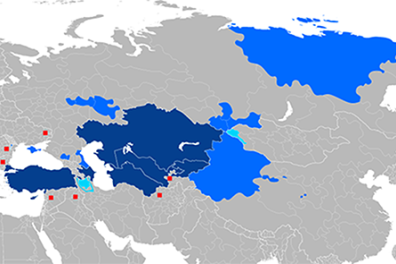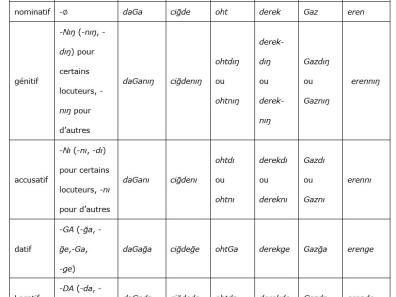The yoghur

Its speakers, who number around 4600, form part of the Yoghours, an ethnic community of approximately 14,000 people professing Lamaic Buddhism and divided into three linguistically. In addition to those who speak the variety of Turkish we're interested in here, there are two other groups: one comprising around 2,800 people who speak Yoghor, a Mongolian dialect, and the other, the majority, made up of monolingual Chinese speakers.
There is much evidence to suggest that the Yoghours are descended from the Uyghurs proper (not to be confused with the Uyghurs of Xinjiang, who chose to call themselves such only at the beginning of the 20th century), a branch of the Turks who played an important role in Upper Asia in the Middle Ages, and whose culture influenced to varying degrees not only other Turkic groups, but also the Mongols, who owe them their principal traditional writing system. The elements in question include:
- the very ethnonym Yoghour, which constitutes a metathesis of Uyghur;
- the use of clan names attested among the Uyghurs, such as that of Yaghlakar, the clan to which belonged the family that founded and ruled the Uyghur Empire (744-840), then the Kingdom of Ganzhou (late 9th century-1028), which it controlled for just over half a century and which extended over a territory including the region inhabited today by the Yoghours ;
- the fact that the use of Old Uyghur Turkic in writing continued among the Yoghurs until at least the early 18th century (witness a copy dating from this period of the Altun Yaruḳ Sudur, the Uyghur translation of the Suvarṇaprabhāsa Sūtra).
Yoghur, which began to be researched a little over a hundred years ago, remains little studied, and while the rare descriptions of this dialect are therefore of great value, the sometimes noticeable differences between them do not fail to raise questions that only new work would eventually be able to answer.
Among the many problematic points that emerge from the confrontation of the data provided by the descriptions mentioned, we would like to mention one which, in our opinion, gives the measure of what remains to be accomplished to give a more exhaustive account of yoghour. According to Malov (1967), Tenichev (1966), Chén and Léi (1985) and Roos (2000), suffixes beginning with n or l when attached to a vowel-terminated base see this consonant become occlusive when the base to which they are attached ends in an occlusive or sibilant.
Or, according to data gathered since 2015 by the author of these lines, in some speakers the initial consonant of the plural subscript, one of the suffixes in question, is not subject to this rule. It follows that, in this particular respect, we are dealing with two systems (in fact, the situation may be even more complex, as it would seem that there are also speakers in whose speech the initial consonant of genitive and accusative definite suffixes is always n).
Furthermore, we note that there is disagreement among the researchers mentioned about the exact quality of the occlusive to which the archiphoneme of the said suffixes passes : While Malov and Tenichev consider that it is realized as voiced after a mute, and voiced in the other cases, Shen and Lei and Roos consider that it has only one realization, voiced according to the first two, voiced according to the last, according to whom, incidentally, yoghour has no sonorous occlusion. On this point, our own data coincide with that of Chén and Léi.
The above observations clearly show that to give a completely faithful overview of yoghour in the current state of research is, if not a challenge, at least no easy task. It goes without saying that the data presented below are by no means definitive, but they should nevertheless give the reader an idea of this dialect. Given the extremely limited number of points that can be covered, we have decided to leave aside those that would have required more extensive development, and concentrate on a few aspects of morphology. For further information, please refer to the bibliography.
1. Derivation
1. 1. Suffix used to form denominative nouns
-çı : araçı "matchmaker" < ara "interval", emçı "doctor" < em
"medicine", lomaḳçı "storyteller" < lomaḳ "tale", pıdığçı "teacher"
< pıdığ "writing".
1. 2. Suffixes used to form denominative verbs
-A: sana- "count" < san "number", yasa- live < yas "year of age";
-LA: başda-"begin" < baş"head", ḳamna-"perform a shamanic dance" < ḳam "shaman", pipiŋna-"criticize" < pipiŋ "critic".
1. 3. Suffixes used to form deverbative nouns
-Gı : sanağı "Buddhist rosary" < sana- "count";
-Gış : dahrtGış "balance" < < dahrt- "weigh";
-ım : bılım "knowledge" < bıl- "to know", yarım "half" < yar- "to split", yülım "death" < yül- "to die";
-ma: çoGema "chair" < çoGe- "to sit".
1. 4. Suffixes used to form deverbative verbs
1.4.1. Voice suffixes
1.4.1.1. Suffixes used to put certain verbs into passive voice
-(V)l(ı) (-ıl, -ul in almost all cases, -lı after bases ending in r): yarlı-"to split" < yar-"to split";
-(V)n: alın-"to be taken" < al-"to take".
1.4.1.2. Suffixes used to put verbs into factive voice
-ır, -ir, -ur, -ür: yülır- "to kill" < yül- "to die";
-t : çoGet- "make sit" < çoGe-"sit", darat-"make comb" < dara-"comb".
1.4.2. Negation suffix -M(A) (-ma, -me, -ba, -be, -M before the suffix -enı)
It is used to form the negation of most verbal forms.
barma-"not to go" < bar-"to go", gelme-"not to come" < gel-"to come",
satba-"don't sell" < sat-"sell", etbe-"don't do" < et-"do", almenı
"don't take! " < al- "take", duhtbenı "don't hold!" < duht-"hold".
2. Flexion
2.1. Nominal inflection
The noun can be affected by plural, possessive and case marks which, when accumulated, appear in this order.
2.1.1. The plural
It is expressed via a suffix in the form -LAr (-lar, -ler, -dar, -der, -nar, -ner)in some speakers, in the form -lAr (-lar, -ler)in others: aGalar "elder brothers" < aGa "elder brother", çiler "camels" < çi "camel", yağlar "oils" < yağ "oil", gereller "lamps" < gerel "lamp", ahtdar or ahtlar "horses" < aht "horse", Gazdar or Gazlar "geese" < Gaz "goose", erenner or erenler "men (= male persons)" < eren "man", aŋnar or aŋlar "joints (of the body) < aŋ "joint".
2.1.2. Possessive affixes
Yoghour has two possessive affixes. The paradigm they constitute is as follows:
1st and 2nd persons: -(ı)ŋ "my" / "ma", "your" / "ta" - "our", "your";
3rd person: -(s)ı(n) "his" / "his" - "their".
In current common usage, use of the first of these memes seems limited to a few nouns, including most of those expressing kinship: anaŋ "my/ta/our/your mother" < ana "mother", Gızıŋ "my/ta/our/your daughter" < Gız "daughter".
The 3rd person possessive affix, for its part, calls for no particular observation: atı "his/their name" < at"name", yüsı"his/their house" < yü"house".
2.1.3. Cases
Following the descriptions of Tenichev (1966) and Shén and Léi (1985), six case suffixes can be distinguished in yoghur. These are shown in the table below:

Adrien Alp Vaillant
Doctor at Inalco, associate member of CETOBAC
Bibliography
Chén (Zōngzhèn) 陳宗振, Léi (Xuǎnchūn) 雷選春, Xībù Yùgùyǔ jiǎnzhì 西部裕固語簡誌 (Esquisse du yoghour occidental), Beijing, Mínzú chūbǎnshè民族出版社, 1985.
Chén (Zōngzhèn) 陳宗振, Léi (Xuǎnchūn) 雷選春, Xībù Yùgù Hàn cídiǎn 西部裕固漢詞典 (Western Yoghur-Chinese Dictionary), Chengdu, Sìchuān Mínzú chūbǎnshè四川民族出版社, 1992.
Malov (Sergei Efimovich), Jazyk želtyx ujgurov: slovar' i grammatika (The language of the Yellow Uyghurs: dictionary and grammar), Alma Ata, Izdatel'stvo akademii nauk kazaxskoj SSR, 1957.
Malov (Sergei Efimovich), Jazyk želtyx ujgurov: teksty i perevody (The language of the Yellow Uyghurs: texts and translations), Moscow, Nauka, 1967.
Roos (Martina Erica), The Western Yugur (Yellow Uygur) Language: Grammar, Texts, Vocabulary, doctoral thesis, Leiden, 2000.
Tenichev (Edkhem Rakhimovitch), Todaeva (Bouliache Khoïtchievna), Jazyk želtyx ujgurov (The Language of the Yellow Uygurs), Moscow, Nauka, 1966.
Zhōng (Jìnwén) 鍾進文, Xībù Yùgùyǔ miáoxiě yǔ yánjiū西部裕固語描寫與研究 (Description of Western yoghur), Mínzú chūbǎnshè民族出版社, 2009.
/>